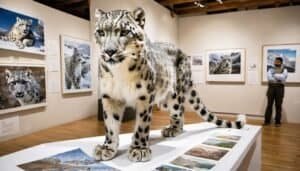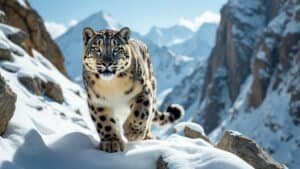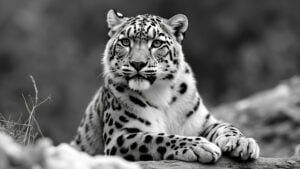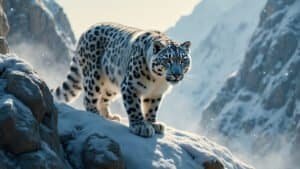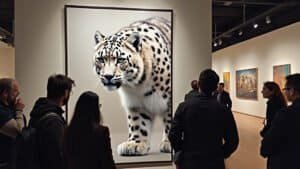Introduction
Snow leopards have captured the imagination of filmmakers and audiences alike. Their elusive nature, stunning beauty, and critical role in the ecosystem make them compelling subjects in both movies and documentaries
This article explores the varied portrayals of snow leopards, delving into their symbolic significance in films, their depiction in documentaries focused on wildlife and conservation, and the evolution of their image over time
By examining these portrayals, we gain insight into how these majestic creatures are viewed culturally and the impact these representations have on public perception and conservation efforts
Symbolism Of Snow Leopards In Films
Snow leopards have long been symbols of mystery, resilience, and the untamed wilderness in films. Their portrayal often transcends mere depictions of wildlife, as these majestic creatures embody deeper themes that resonate with human emotions and cultural narratives
Filmmakers have utilized the image of the snow leopard to convey a range of symbolic meanings, from strength and solitude to survival against the odds. This section will explore how snow leopards are represented in different types of films, including cultural significance, roles in animated and fantasy movies, and iconic films featuring these elusive cats
Cultural Significance And Representation
In many cultures, snow leopards are revered as mystical creatures, often linked to spiritual beliefs and folklore. This reverence is reflected in films where the snow leopard is portrayed as a guardian of the natural world or as a symbol of purity and strength
For example, in some Asian films, the snow leopard is depicted as a sacred animal, embodying qualities such as wisdom and protection. The association of snow leopards with mountainous regions, often seen as remote and untouched by civilization, further enhances their portrayal as symbols of the wild, untainted by human influence
These cultural representations often influence the narrative arcs in films, where the snow leopard’s presence can signify a connection to nature or a journey of self-discovery for human characters
In movies set in the Himalayas or Central Asia, the appearance of a snow leopard might signal a turning point in the story, where characters gain deeper insights into themselves or the world around them. The animal’s elusive nature also plays into its symbolic role, representing the mysteries of life that are beyond human understanding
Role In Animated And Fantasy Movies
Snow leopards have also made their mark in the world of animated and fantasy films, where they are often anthropomorphized and given larger-than-life roles
In these films, snow leopards are frequently depicted as powerful allies, mystical creatures, or formidable adversaries. Their striking appearance—thick fur, piercing eyes, and graceful movements—lends itself well to animation, where these attributes can be exaggerated to create memorable characters
A notable example is the character of Tai Lung from Kung Fu Panda (2008), an animated film where the snow leopard is portrayed as a fierce and skilled warrior. Tai Lung’s character, though an antagonist, embodies the themes of ambition, strength, and the struggle for recognition. His portrayal as a snow leopard adds a layer of mystique and power, enhancing his role as a formidable opponent to the protagonist
This film, among others, illustrates how the snow leopard’s image can be adapted to different narrative contexts, making it a versatile symbol in both children’s and adult entertainment
In fantasy films, snow leopards are sometimes depicted as magical creatures, often with the ability to communicate with humans or possess supernatural powers. These portrayals capitalize on the animal’s association with the mystical and unknown, further cementing its role as a symbol of otherworldliness
Whether as a wise guide or a fearsome guardian, the snow leopard’s presence in these films reinforces its status as a creature of great significance, both in the story and in the cultural imagination
Iconic Snow Leopard Films
Several films have centered around snow leopards or featured them prominently, highlighting their importance in the storyline. The Secret Life of Walter Mitty (2013) is one such film, where the snow leopard plays a symbolic role in the protagonist’s journey
The film uses the snow leopard as a metaphor for the elusive beauty of life, something that cannot always be captured or tamed. In this narrative, the snow leopard represents the ideal of pure, unspoiled nature, something to be admired and respected rather than conquered
Another example is the documentary-style film The Leopard (1984), which, while not solely focused on snow leopards, includes a powerful sequence featuring the animal in its natural habitat
The film uses the snow leopard to explore themes of survival and the harsh realities of life in the wild. The imagery of the snow leopard, moving gracefully through the rugged terrain, serves as a poignant reminder of the delicate balance between life and death in the animal kingdom
These films, among others, showcase the versatility of the snow leopard as a cinematic symbol, capable of conveying a wide range of emotions and themes. Whether as a central figure or a symbolic presence, the snow leopard’s portrayal in film continues to captivate audiences and inspire deeper reflection on the relationship between humans and the natural world
Snow Leopards In Documentaries
Snow leopards have been a focal point in numerous documentaries, often symbolizing the challenges and wonders of the natural world. These films and series not only capture the beauty and mystery of these elusive cats but also highlight the pressing issues surrounding their conservation
Through the lens of documentary filmmaking, snow leopards are portrayed in their natural habitat, facing the harsh realities of survival in some of the most remote and rugged terrains on Earth
This section delves into how documentaries depict snow leopards, emphasizing their environment, the conservation messages conveyed, and the difficulties filmmakers face in capturing these rare creatures on camera
Depiction Of The Wild And Natural Habitat
Documentaries about snow leopards often emphasize the harsh, yet stunningly beautiful environments these animals inhabit. The Himalayan mountains, with their towering peaks and expansive, rugged landscapes, provide the perfect backdrop for showcasing the snow leopard’s natural habitat
These films frequently highlight the solitary and elusive nature of snow leopards, emphasizing their adaptation to extreme conditions and their reliance on the mountainous terrain for hunting and shelter
For instance, the acclaimed BBC series Planet Earth II (2016) features a breathtaking segment on snow leopards, filmed in the remote mountains of Asia. The documentary captures the snow leopard’s life in the wild, showing its agility and strength as it navigates steep cliffs in pursuit of prey
The stunning cinematography not only brings viewers closer to the elusive predator but also emphasizes the challenges of survival in such a harsh environment. These portrayals help viewers appreciate the resilience of snow leopards and the delicate balance of their ecosystem
Documentaries often use such depictions to underscore the fragility of the snow leopard’s existence, with their habitat threatened by climate change and human encroachment
The vast, seemingly untouched landscapes that snow leopards roam are presented as both majestic and vulnerable, adding a layer of urgency to the conservation messages these films aim to convey
Conservation Themes And Awareness
One of the primary objectives of snow leopard documentaries is to raise awareness about the species’ endangered status and the conservation efforts needed to protect them. Documentaries often include interviews with conservationists, scientists, and local communities who are involved in the preservation of snow leopard populations
These films not only provide scientific insights into the behavior and ecology of snow leopards but also discuss the socio-economic factors that impact their survival, such as poaching, habitat destruction, and human-wildlife conflict
The documentary Ghost of the Mountains (2017), produced by Disneynature, is a prime example of how filmmakers use storytelling to promote conservation. The film follows a team of dedicated conservationists and filmmakers as they attempt to document the life of a snow leopard in the wild
It explores the threats snow leopards face, including illegal hunting and shrinking habitats, while highlighting the efforts made to mitigate these dangers. By presenting the snow leopard as a species on the brink of extinction, the documentary seeks to inspire viewers to support conservation initiatives and advocate for the protection of these majestic animals
Another significant documentary, The Snow Leopard: Beyond the Myth (2008), delves into the myths and realities surrounding snow leopards, challenging misconceptions and highlighting the need for conservation. The film provides an in-depth look at the snow leopard’s behavior and ecology, while also addressing the human challenges of living alongside such a powerful predator
The documentary emphasizes that the survival of snow leopards is intricately linked to the well-being of local communities, promoting the idea of coexistence as a key strategy in conservation efforts
Through these films, the snow leopard is portrayed not just as a majestic animal, but as a symbol of broader environmental challenges
Documentaries play a crucial role in educating the public about the importance of preserving not only the snow leopard but also the entire ecosystem it represents. The narrative of conservation is interwoven with the depiction of the animal’s natural beauty and the pressing need for action to ensure its continued survival
Challenges In Filming Snow Leopards
Filming snow leopards is notoriously difficult due to their elusive nature and the extreme environments they inhabit. Documentaries often highlight the lengths to which filmmakers must go to capture footage of these secretive animals, adding a layer of drama and excitement to the narrative
These challenges include the physical demands of operating in remote, high-altitude regions, the technical difficulties of setting up equipment in harsh weather conditions, and the patience required to wait for days, or even weeks, for a single sighting
For example, the documentary Snow Leopard: Beyond the Silence (2021) showcases the arduous journey of a film crew attempting to document snow leopards in the wild
The filmmakers spend months in the field, battling freezing temperatures, treacherous terrain, and the constant uncertainty of whether they will even catch a glimpse of the elusive predator. This dedication not only underscores the difficulty of filming snow leopards but also serves to highlight the incredible resilience of the animal itself, thriving in some of the most inhospitable places on Earth
Advanced technology, such as remote cameras and drones, has significantly aided filmmakers in capturing rare footage of snow leopards
Documentaries often provide behind-the-scenes insights into how these technologies are used to track and film snow leopards without disturbing their natural behavior. This innovative approach to wildlife filmmaking has led to some of the most intimate and revealing footage of snow leopards ever recorded, allowing viewers to witness behaviors that were previously undocumented
These challenges, while daunting, also add to the allure of snow leopard documentaries. The effort and perseverance required to film these animals mirror the tenacity of the snow leopards themselves, creating a powerful narrative that resonates with audiences
By documenting the difficulties faced in capturing these creatures on film, documentaries not only tell the story of the snow leopard but also the story of those who dedicate their lives to preserving and showcasing this magnificent species
Evolution Of Snow Leopard Portrayals
The portrayal of snow leopards in films and documentaries has evolved significantly over the decades, reflecting changes in both filmmaking techniques and public attitudes towards wildlife
Initially depicted as mysterious and untouchable predators, snow leopards have gradually been recognized as vulnerable species in need of protection
This section will explore the evolution of snow leopard portrayals in media, focusing on early films and documentaries, modern interpretations, and the impact these portrayals have had on public perception and conservation efforts
Early Films And Documentaries
In the early days of wildlife filmmaking, snow leopards were often depicted as enigmatic and nearly mythical creatures, rarely seen by humans and shrouded in mystery
Early films and documentaries, dating back to the mid-20th century, generally portrayed snow leopards as solitary hunters, emphasizing their role as apex predators in the harsh environments of the Himalayas and Central Asia
The limited technology and knowledge about these animals meant that much of their portrayal was based on speculation and the occasional rare footage captured by explorers or naturalists
One of the earliest significant appearances of snow leopards in film was in documentaries produced by organizations like National Geographic in the 1960s and 1970s. These early documentaries focused primarily on the hunting prowess of snow leopards, showcasing their ability to navigate treacherous mountain terrain in pursuit of prey
The portrayal was often dramatic, emphasizing the animal’s power and stealth, which captivated audiences but offered little insight into the snow leopard’s behavior beyond its role as a predator
As the interest in wildlife conservation began to grow in the latter half of the 20th century, the portrayal of snow leopards began to shift
Documentaries started to focus more on the challenges faced by snow leopards, such as habitat loss and poaching, rather than just their predatory instincts. This marked the beginning of a more nuanced and empathetic portrayal of snow leopards, highlighting their plight and the need for conservation efforts
Modern Interpretations And Approaches
In recent years, the portrayal of snow leopards has become increasingly sophisticated, driven by advancements in technology and a deeper understanding of their ecology and behavior
Modern documentaries and films now emphasize the intricate relationships snow leopards have with their environment, their prey, and even local human populations. The focus has shifted from depicting them solely as fearsome predators to exploring their vulnerability and the complex ecological systems they are a part of
The use of high-definition cameras, drones, and thermal imaging has allowed filmmakers to capture snow leopards in unprecedented detail, revealing aspects of their lives that were previously unknown
For example, recent documentaries have documented rare footage of snow leopards with their cubs, displaying tender moments that challenge the traditional image of these animals as solitary and fierce. This more rounded portrayal of snow leopards helps humanize them, fostering a greater emotional connection with audiences
Moreover, modern films often incorporate the voices and stories of local communities who live alongside snow leopards. By doing so, these documentaries provide a more holistic view of the challenges faced by both the animals and the people who share their habitat
This approach not only enhances the narrative but also highlights the importance of community-based conservation efforts, where the survival of snow leopards is seen as intertwined with the well-being of human populations
Impact Of Portrayal On Public Perception
The evolving portrayal of snow leopards in films and documentaries has had a significant impact on public perception, influencing how these animals are viewed and the level of support for their conservation
Early depictions of snow leopards as powerful and elusive predators captivated audiences, but it also kept them at a psychological distance, seen more as exotic curiosities than as animals in need of protection
As the narrative shifted towards a focus on vulnerability and conservation, public perception began to change. Documentaries that highlighted the threats snow leopards face—such as The Vanishing Lions (1985)—played a crucial role in raising awareness about the species’ endangered status
These films not only educated viewers about the ecological importance of snow leopards but also fostered empathy, positioning the animals as symbols of the broader environmental challenges facing the planet
This shift in perception has been instrumental in garnering support for conservation initiatives. Organizations like the Snow Leopard Trust have leveraged the growing public interest and concern generated by these films to promote conservation programs, secure funding, and advocate for policies that protect snow leopards and their habitats
The portrayal of snow leopards as both majestic and vulnerable has helped transform them into icons of wildlife conservation, inspiring action to preserve not only these magnificent cats but also the ecosystems they inhabit
The impact of these portrayals extends beyond individual films, contributing to a broader cultural shift towards valuing and protecting biodiversity. As more people become aware of the challenges facing snow leopards, there is a growing recognition of the need for sustainable practices that support both wildlife and local communities
The evolution of snow leopard portrayals in media, therefore, reflects and reinforces changing attitudes towards wildlife conservation, demonstrating the power of film to influence public perception and drive positive change
Conclusion
The portrayal of snow leopards in movies and documentaries has evolved significantly, reflecting broader changes in how we view and value wildlife
From early depictions that emphasized their role as elusive predators to modern narratives focusing on their vulnerability and the need for conservation, snow leopards have become powerful symbols in film
Documentaries, in particular, have played a crucial role in raising awareness about the challenges these majestic animals face, helping to foster a deeper connection between audiences and the natural world. Through these evolving portrayals, snow leopards continue to captivate and inspire, serving as a poignant reminder of the importance of preserving our planet’s biodiversity



